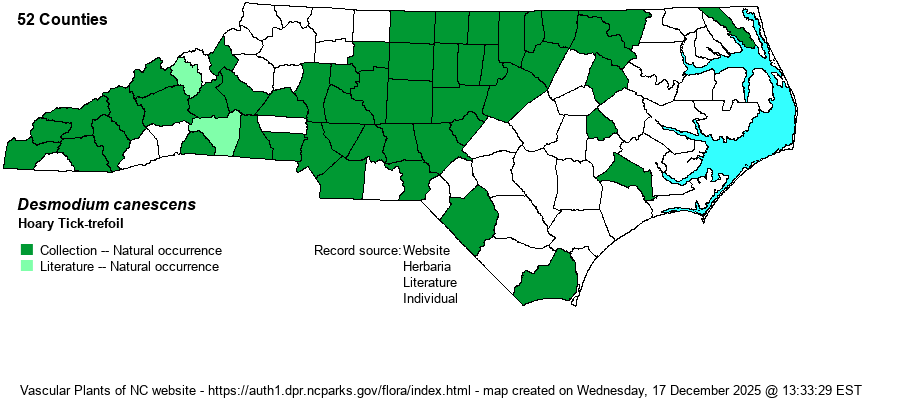| Author | (L.) de Candolle | |
| Distribution | Nearly throughout the Piedmont and Mountains, but very rare to absent in the northwestern corner of the state. Widely scattered in the Coastal Plain.
This is a widespread species in the Eastern U.S., ranging to southern New England and NE, and south to central FL and eastern TX. | |
| Abundance | Fairly common to frequent in the eastern and central Piedmont, and fairly common in the southern and central Mountains, at least at lower elevations. Scarce in the northwestern Piedmont and northern Mountains, where probably present but rare. Rare in the Coastal Plain, mainly in the northern portions. | |
| Habitat | This species occurs in habitats similar to those of many or most other Desmodium species in the state -- wooded borders, old fields, openings in upland woods, and other areas in partial shade. It favors mesic soils -- not dry but not wet, either. | |
| Phenology | Blooms from June into August, and fruits from August to October. | |
| Identification | This is probably the "bushiest" of the state's many Desmodium species. Even though it is herbaceous like the others, it often grows to about 3 feet tall (occasionally to 4 feet tall) and typically wider, with numerous wide-spreading branches. It has finely-hairy branches and stems, often also a bit sticky (glandular). The leaves are rather typical for the genus, being trifoliate, with the central leaflet being ovate and reaching 3 inches long, with the lateral ones also ovate but around 2 inches long. Quite noticeable is that the flowers usually turn greenish-blue in late bloom; the racemes of numerous (and larger than in most others in the genus) rosy-pink flowers tip the many branches. Thus, the species is normally not hard to identify, by 1) its very bushy look (often wider than long), 2) quite hairy stems and leaf petioles, and 3) flowers that turn greenish-blue in later stages. It should not be too hard to find in typical settings in most of the Piedmont or southern mountains -- woodland borders and other edge habitats. | |
| Taxonomic Comments | None
| |
| Other Common Name(s) | This is a rare case of a Desmodium with near total agreement of the common name! | |
| State Rank | S4? [S5] | |
| Global Rank | G5 | |
| State Status | | |
| US Status | | |
| USACE-agcp | | |
| USACE-emp | | |

